Objective: To explore the feasibility of using video game system for training to improve clinical measures of balance in ageing adults with mild to moderate intellectual disability (ID).
Subjects and Methods: 16 adults diagnosed with mild to moderate ID, aged 40 or above and attending workshop were recruited to receive 21 sessions of 20 minutes video game training using HUR Balance Trainer BT4. Pre- and post-score of participants’ balance ability by Romberg test and limit of stability test were obtained. Wilcoxon’s test of SPSS was adopted to analyse the data of pre-and post-test to compare the differences.
Results: Significant results were found in the pre-and post-data of “static balance score” and “leftward limit of stability”.
Conclusion: The results revealed that video games could improve some aspects of the balance ability in ageing adults with mild to moderate ID. More in-depth research is needed.
Keywords: Psychological science, Intellectual disability, Functional decline, Healthy adults
People with intellectual disability (ID) have a higher chance of fall as they usually have an earlier decline in balance compared with normal population.1-3 Therefore, balance training is crucial to prevent fall and the related consequences like fracture, functional decline, decreased quality of life, etc.4
Traditional balance training includes weight shifting, single leg standing, perturbations, performing activities on an unstable surface and using a narrow base of support (BOS).5 For clients with mild to moderate ID, they may not be able to fully understand the instructions of traditional balance training activities. In recent years with the advancement of technology, video games have been highly utilized as an option in balance training. Use of video games will be easier for individuals with mild to moderate ID to understand and follow the requirements of balance training when compared with traditional methods. In fact, video games were found to be more enjoyable than traditional balance training in healthy adults.6 Past studies examining the effect of using video games in balance training revealed that it is an effective tool on balance rehabilitation for patients with cerebral palsy,7 Parkinson disease,8 stroke9 and older adults.10 However, literature concerning video games in people with intellectual disability is sparse.11 Therefore, the purpose of the present study is to explore the feasibility of using video game system for training to improve clinical measures of balance in ageing adults with mild to moderate ID. Romberg test and limit of stability test were used before and after training to represent changes in the balance capability of participants.
Design
It was a one-group pretest-posttest design conducted at sheltered workshop.
Participants
Adults diagnosed with mild to moderate ID, aged 40 or above, were recruited from two sheltered workshops of our organization (JCBSW and KTSW) for the present study. A total of twenty participants were selected. All participants were able to walk independently. There were four dropouts, and thus, 16 participants completed all intervention sessions and assessment procedure. Please see Figure 1 for the flowchart.
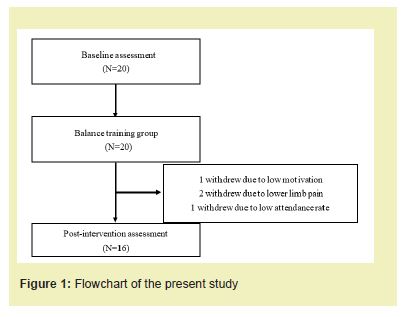
Procedure
The participants completed 21 sessions of video game training over 3 months using HUR Balance Trainer BT4, with duration of 20 minutes in each session.
Balance training station using HUR balance trainer BT4
A balance training station was formed by HUR Balance Trainer BT4 (balance platform) and SmartBalance Software for assessing balance and providing balance training. The balance platform was a four-channel portable force platform and the setup was simply by connecting the balance platform via direct USB-cable connection to a computer with the Smart Balance software installed. The balance platform was calibrated prior to testing and the channels were checked before every test.
The research station targeted the 2 components of balance: sensory orientation and stability limits. Sensory orientation is the control of standing balance by visual, vestibular or surface somatosensory information.12 Stability limit means how far the body can move over its BOS without changing the support or losing balance.12 Past studies also used the balance platform and SmartBalance software for assessing balance abilities. For example, Kim carried out the measurement of center of pressure (COP) values with quiet standing by the balance platform 13 and Piirainen measured the displacement of COP value with perturbation by the balance platform.14
For intervention, the balance training adopted an interactive training mode and immediate visual feedback was provided to participants for improving balance and coordination skills. All participants received video game balance training using the balance training station. According to the general condition of the participants, 4 items of the training program, as shown in Figures 2-5, were selected. In the balance training station, participants were instructed to stand on the balance platform and shift their body weight (without stepping) in order to control the movement of the character (a penguin) to complete the mission, for example finishing a maze while collecting stars, chasing a moving target and following a static track.
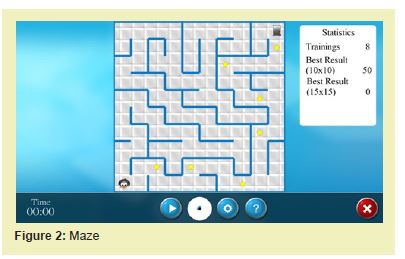
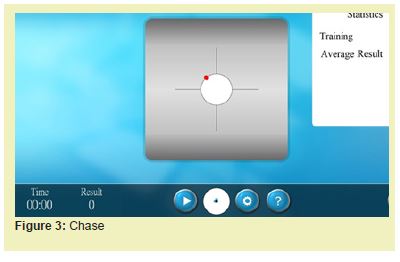
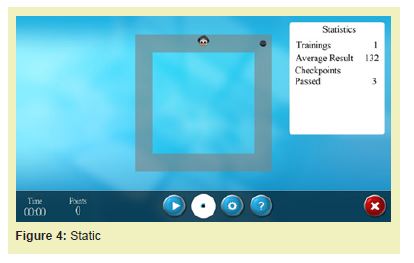
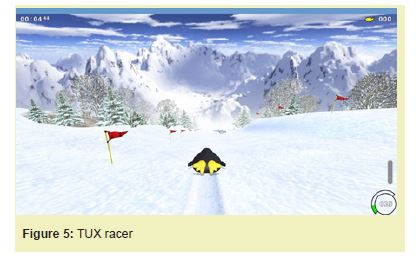
Outcome measurements
In the research station, participants were instructed to perform 2 tests: Romberg test and limit of stability (LOS) test.
The Romberg test removed the visual and vestibular components that contribute to control of standing balance, resulting in identifying patients with specific proprioception difficulties for purposes of intervention and improving participants’ outcomes.15 Participants were instructed to look straight ahead and stand as still as possible with arms hanging down and feet at an angle of 30 degrees between the medial sides of the feet. There were 4 sub-tests as shown in Figure 6: eyes open, eyes closed, eyes open unstable and eyes closed unstable. A special foam was placed on the balance platform to provide an unstable surface for the sub-tests.
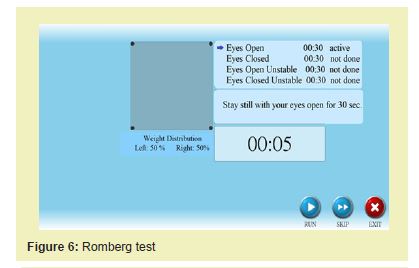
LOS test measured the range and volitional control which individuals could transfer their COP within their BOS without changing the support or losing balance.16 Participants were instructed to perform the test in a normal standing position and lean as far as possible to 4 different directions as shown in Figure 7: lean forward, lean rearward, lean leftward and lean rightward.
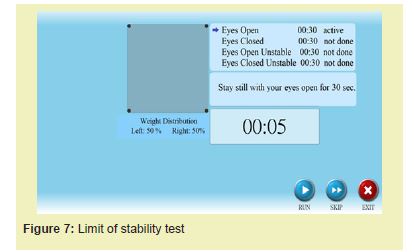
Physiotherapists were responsible for carrying out all assessments and data collection procedures. The present study used Romberg test and LOS test to represent balance ability of participants. Since the study adopted one group pretest-posttest design, collection of participants’ results on Romberg test and LOS test was done before (baseline assessment) and after (post-intervention evaluation) they had finished the 3 months balance training. Both of the tests were done using HUR Smart Balance Software in the equipment HUR balance BT4. The use of assessment tool had the advantage of quantifying the results in score which was shown in Figure 8 and 9, and based on past study.14 With quantified results, it was more feasible to analyze any differences between baseline assessment and post-intervention evaluation.
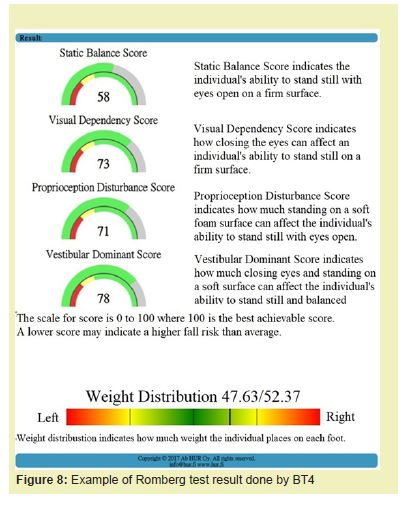
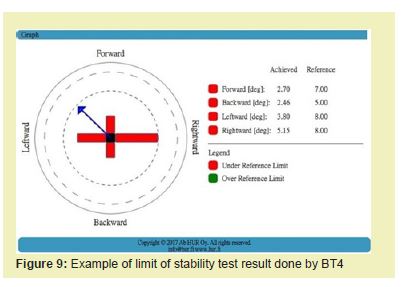
Statistical analyzes
The results of Romberg test data and LOC test data were analyzed separately to reflect change in respective scope of balance ability. SPSS version 25 (IBM Corporation, NY, the USA) was used for all statistical analysis. We adopted Kolmogorov-Smirnov test to check the normality of data distributions and found some of the data were not normally distributed, so non-parametric test was preferred. Therefore, the Wilcoxon signed-rank test was used to compare the pre- and post-intervention values. All statistical significance levels (ɑ) were set at <.05.
Our results included data for 16 participants. Participants’ characteristics were shown in Table 1.
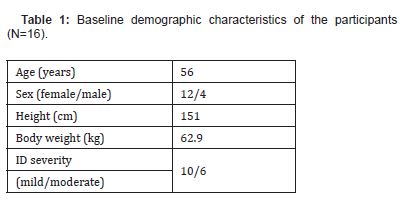
Sensory orientation
In the Romberg test, increment was found in the mean of all outcome measures and significant difference in static balance score was observed on the basis of the pre- and post-intervention comparison in Table 2 (p <.05).
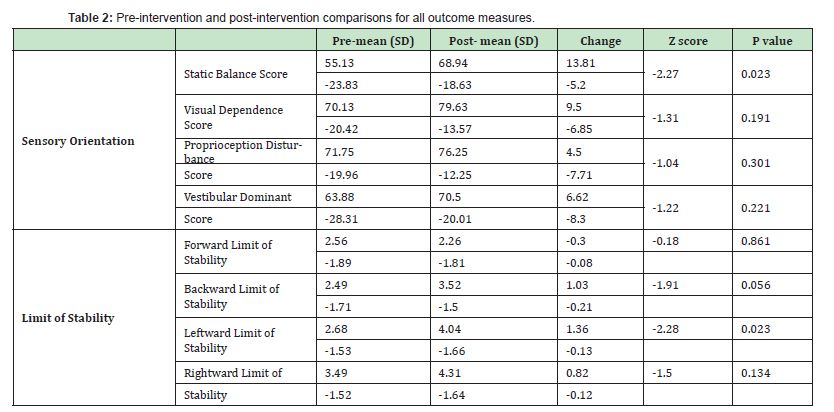
Limit of stability
In the LOS test, increment was found in the means of all outcome measures except forward limit of stability. Significant difference in leftward limit of stability was observed on the basis of the pre- and post-intervention comparison in Table 2 (p <.05).
Previous study found that short balance training program of 4-5.5 weeks were unable to obtain significant improvement in postural control and balance.17 On the other hand, a significant improvement in balance outcomes had been shown in a 12-week program with 2 sessions per week.18 Hence, our study was originally designed to cover 12 weeks of training with 2 sessions per week. However, due to the impact of COVID-19 pandemic, the attendance of the participants was affected, so we adjusted the training program to be 1-3 session(s) per week for a total of 21 sessions.
In this study, HUR Balance Trainer BT4 was used as an assessment and therapeutic intervention tool to improve components of balance, including sensory orientation and stability limits, in ageing adults with mild to moderate ID. After the intervention, better results of all sensory orientation outcome measurement expressed by the mean value were found, and static balance was significantly improved. Static balance reflects the ability of postural control to minimize body sway in a quiet stance condition. Previous systematic review found that studies demonstrated the largest effect size relied on tai chi exercise, balance and/or strength exercise, Wii Fit balance game training and rope- skipping exercises on the static balance of young people with intellectual disabilities.19 Our results matched with previous studies that virtual games could improve balance skills of individuals with ID.20,21
On the other hand, increment was found in the mean of all limit of stability outcome measures except forward limit of stability and significant improvement was found only in leftward limit of stability. Previous study found that all participants, no matter persons with or without intellectual disabilities, demonstrated significantly better static balance skills on right leg than on left leg.22 Similarly, in this study, the mean of rightward limit of stability was higher than that of leftward limit of stability in the baseline assessment. For this interesting result, we considered if dominant leg could be the factor of better limit of stability skill. Further investigation could be analyzed for the effect of dominant leg on limit of stability skill.
There were several limitations in this study. Firstly, our sample size was small, with only 16 subjects which a majority of the subjects were female. Secondly, we have no control group and the assessors were not blinded during data collection. Thirdly, balance ability is closely related to lower limbs muscle strength,20,23 but the video games of the HUR Balance Trainer BT4 did not involve any muscle strengthening components. Fourthly, we didn’t have follow-up data to investigate whether the effect of video games could persist over time after training had been stopped. Fifthly, during the intervention period, it was challenging for the participants to complete the training while standing on foam and the balance training station rely on immediate visual feedback. Hence, the training effect on proprioception and visual disturbance had been minimized.
This study explored the feasibility of using video game system for training to improve clinical measures of balance in ageing adults with mild to moderate ID. The results revealed that video game system could improve some aspects of the balance ability in ageing adults with mild to moderate ID. Significant results were found in the pre-and post-data of “static balance score” and “leftward limit of stability”. Generally, the mean of rightward limit of stability was higher than that of leftward limit of stability in the baseline assessment. We considered dominant leg could be attributed to better limit of stability skill. Further investigation could be analyzed for the effect of dominant leg on limit of stability skill. More in-depth researches with greater sample size, better study design, follow up period and more challenges like visual disturbance during video game intervention are suggested.
None.
This Research Article received no external funding.
Regarding the publication of this article, the authors declare that they have no conflict of interest.
- 1. Axmon A, Ahlström G, Sandberg M. Falls resulting in health care among older people with intellectual disability in comparison with the general population. J Intellect Disabil Res. 2019;63(3):193-204.
- 2. Chen JL. Comparison of balance control between mental retardation and normal students. J Phys Educ Sports. 2006;17:29-42.
- 3. Enkelaar L, Smulders E, van Schrojenstein Lantman-de Valk H, et al. A review of balance and gait capacities in relation to falls in persons with intellectual disability. Res Dev Disabil. 2012;33(1):291-306.
- 4. Abraham S. Fall Prevention Conceptual Framework. Health Care Manag (Frederick). 2020;39(4):144-149.
- 5. Westcott SL, Murray KH, Pence K. Survey of the preferences of pediatric physical therapists for assessment and treatment of balance dysfunction in children. Pediatric Physical Therapy. 1998;10(2):48.
- 6. Brumels KA, Blasius T, Cortright T, et al. Comparison of efficacy between traditional and video game based balance programs. Clinical Kinesiology. 2008;62:26-31.
- 7. Gatica Rojas V, Méndez Rebolledo G, Guzman Muñoz E, et al. Does Nintendo Wii Balance Board improve standing balance? A randomized controlled trial in children with cerebral palsy. Eur J Phys Rehabil Med. 2017;53(4):535-544.
- 8. Santos P, Scaldaferri G, Santos L, et al. Effects of the Nintendo Wii training on balance rehabilitation and quality of life of patients with Parkinson's disease: A systematic review and meta-analysis. NeuroRehabilitation. 2019;44(4):569-577.
- 9. Karasu AU, Batur EB, Karataş GK. Effectiveness of Wii-based rehabilitation in stroke: A randomized controlled study. J Rehabil Med. 2018;50(5):406-412.
- 10. Manlapaz DG, Sole G, Jayakaran P, et al. A Narrative Synthesis of Nintendo Wii Fit Gaming Protocol in Addressing Balance Among Healthy Older Adults: What System Works?. Games Health J. 2017;6(2):65-74.
- 11. Rodríguez Jiménez M, Pulina F, Lanfranchi S. Video games and Intellectual Disabilities: a literature review. 2015.
- 12. Horak FB, Wrisley DM, Frank J. The Balance Evaluation Systems Test (BESTest) to differentiate balance deficits. Phys Ther. 2009;89(5):484-498.
- 13. Kim N, Yoo K, An H, et al. The Effects of Balance Exercise on an Unstable Platform and a Stable Platform on Static Balance. Journal of International Academy of Physical Therapy Research. 2014;5: 641-646.
- 14. Piirainen JM, Linnamo V, Cronin NJ, et al. Age-related neuromuscular function and dynamic balance control during slow and fast balance perturbations. J Neurophysiol. 2013;110(11):2557-2562.
- 15. Forbes J, Cronovich H. Romberg Test. StatPearls. 2020.
- 16. Juras G, Kajetan S, Fredyk A, et al. Evaluation of the Limits of Stability (LOS) Balance Test. Journal of Human Kinetics. 2008;19:39-52.
- 17. Verhagen E, Bobbert M, Inklaar M, et al. The effect of a balance training programme on centre of pressure excursion in one-leg stance. Clin Biomech (Bristol, Avon). 2005;20(10):1094-1100.
- 18. Cooper T, Williams J. Does an exercise program integrating the Nintendo Wii-Fit Balance Board improve balance in ambulatory children with cerebral palsy?. Physical Therapy Reviews. 2017;22:1-9.
- 19. Maïano C, Hue O, Morin AJS, et al. Exercise interventions to improve balance for young people with intellectual disabilities: a systematic review and meta-analysis. Dev Med Child Neurol. 2019;61(4):406-418.
- 20. Hsu TY. Effects of Wii Fit(®) balance game training on the balance ability of students with intellectual disabilities. J Phys Ther Sci. 2016;28(5):1422-1426.
- 21. Lotan M, L Weiss P. Improving Balance in Adults With Intellectual Developmental Disorder via Virtual Environments. Percept Mot Skills. 2021;128(6):2638-2653.
- 22. Klavina A, Jekabsone I. Static balance of persons with intellectual disabilities, visual impairment and without disabilities. European Journal of Adapted Physical Activity. 2014;7:50-57.
- 23. Nitz JC, Kuys S, Isles R, et al. Is the Wii Fit a new-generation tool for improving balance, health and well-being? A pilot study. Climacteric. 2010;13(5):487-491.

